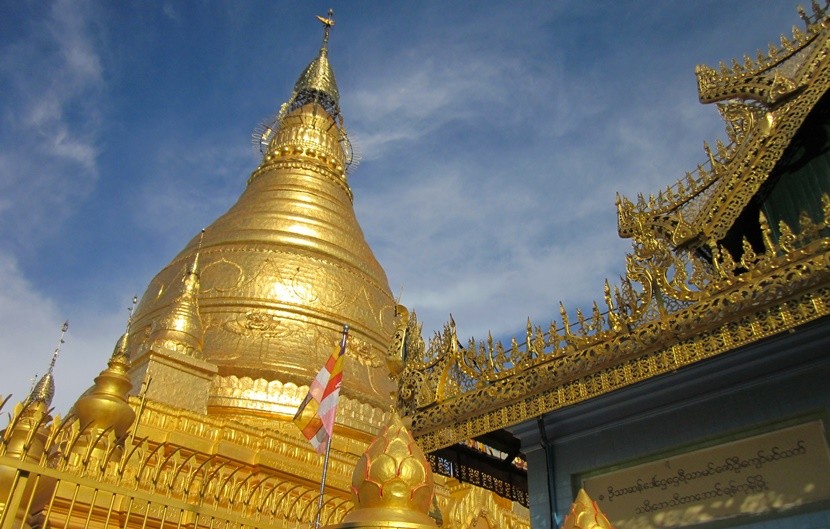
You might also like:
Visiting Myanmar feels like you’re traveling through time — you’ll see locals wearing traditional Longyi, hand-woven skirts with trays of warm rice and salted curries perched upon their heads, while the sounds of this exciting city waft around you. Thanks to little or no outside influence, the country remains super-authentic, the type of Asia you read about in a Rudyard Kipling poem. I’d been dreaming of seeing the crumbling temples of Bagan my whole life and decided to also pay a visit to Mandalay in favor of busy Yangon. Here are some highlights from my travel adventures in this spectacular country.

Start with a visit to Mandalay Palace, which was constructed between 1857 and 1859 — foreigners can only enter through the East Gate, admission is 10,000 Kyats (~$8) — bring your passport as you won’t be allowed entry without it. In lieu of supporting the government by paying this tax to enter, I chose to ride my bike around the perimeter walls and moat instead. It’s a perfect square — each of the four walls are about 1.2 miles long — so you’ll enjoy a ride of about 4.8 miles if you bike the entire perimeter like I did. The sights and smells of locals working, cooking, resting and eating are also interesting when you’ve had enough of the Palace and moat views. You may also spot people napping on the sidewalk, a common practice here for escaping the midday heat.

Next, ride up to Mandalay Hill and check out Sandamuni Pagoda, where you can wander among the 1,744 small white shrines and be filled with an overwhelming sense of awe when you spot the grand finale: A massive golden pagoda in the middle of the complex. If that’s not enough, the pagoda also features the largest iron image of Buddha in Myanmar, the Sandamani, made from 41,000 pounds of iron.

Best reached by car or tuk tuk, Sagaing Hill is also home to a number of peaceful temples and pagodas. Once the car drops you off, you’ll still have quite an uphill hike to conquer, but it’s totally worth it to see the hundreds of caged buddhas, meditating monks and, best of all, incredible panoramic views of Mandalay, the massive Irrwadday River and the green rice terraces beyond.

The nearby villages of Amanpura and Inwa definitely warrant a visit as well. Amanpura boasts the U Bein Bridge, the longest teak footbridge in the world — I recommend taking a boat over to the village, exploring it to your heart’s content, and walking back across the bridge. Your next stop: Inwa — a village that allows no roads or cars, meaning you’ll have to take a boat over and visit its many temples via horse cart for a bumpy-but-memorable experience.

Bagan is another awe-inspiring city to add to your list, with more than 2,000 temples, pagodas, shrines and ruins scattered over 25 square miles of space about 111 miles southwest of Mandalay. The temples date back to the 11th to 13th centuries, and I can’t think of a more exciting place to get caught up in exploring.
Locals, as well as tourists, visit the Bagan temples daily, so it’s not uncommon to find people offering prayers or worshipping statues of Buddha. Remember to be respectful and make sure to use proper etiquette when visiting, as these spots are considered holy — always take off your shoes before entering and never point your feet at Buddha while sitting in the temple.

While I wasn’t able to charter a hot air balloon ride during my visit — unfortunately, they aren’t offered during the rainy season — I still managed to get some great panoramic views by climbing to the tops of many temples. I couldn’t resist catching a beautiful Bagan sunset. One of the best places to see the sun go down over the temples and plains is from the Shwesandaw Paya pagoda — avoid the crowds by going to one of the lower levels instead of the very top.
While horse and buggy used to be the preferred method of transportation to see the temples, nowadays it’s all about the e-bike — rent your own electric bike for just a few bucks a day and zip through the dirt roads quickly and easily.

Finally, don’t forget to pay a visit to the mighty Irrawaddy River. Dawn is the most spiritual time to visit and you’ll see locals praying and giving alms to the monks. River cruises are available between Mandalay and Bagan during the dry season and are a great way to explore the Myanmar riverside.

A Final Tip
Normally, I’d recommend using cards like the Chase Sapphire Preferred and Citi Prestige because they don’t charge foreign transaction fees when you travel abroad, however, the country is still opening up and most places here don’t yet accept credit cards. The good news is you can still use these cards to book your flights and hotels before you go — you’ll earn 2x points on travel expenses with the Chase Sapphire Preferred card and 3x points on airfare and hotels when you use the Citi Prestige. Once you’re there, I highly recommend having US dollars ready to exchange for local currency.
Source: thepointsguy.com
